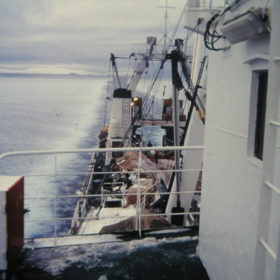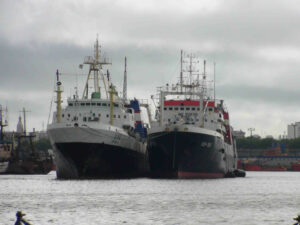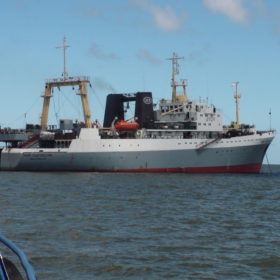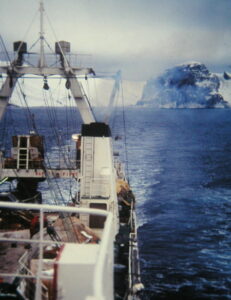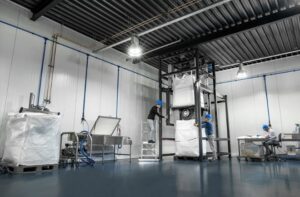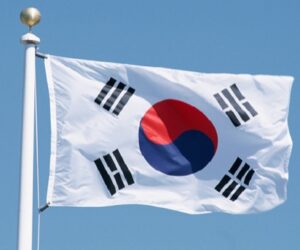Financial and Technical Analysis (2007).
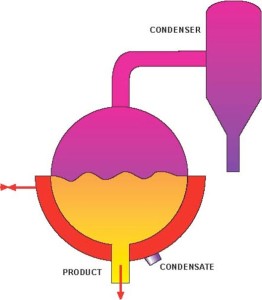 Alternative evaporation solutions were analyzed for a theoretical 7 700GRT factory trawler targeting South Antarctic krill resource. The concept is an evaporator designed for recovering a solvent or solutes from a solution. Different types of Evaporators were researched such as, but not restricted to; raising film contra pressure and pressure-vacuum; Falling film units operating with boiler’s steam (SHE- Steam Heated Evaporator) or with waste vapors (WHE – Waste Heated Evaporators); Mechanical Vapor Recompression (MVR) Evaporators; Thermal vapor recompression units (TVR); Plate or cassette evaporators; Forced flow/flash Evaporators; Scraped surface Evaporators. Each equipment was calculated for this specific project. The residual-fluoride content on the resulting soluble, as well as for the stick water, must necessarily be considered although it proved not to be a restrictive issue for a proper evaporation activity.
Alternative evaporation solutions were analyzed for a theoretical 7 700GRT factory trawler targeting South Antarctic krill resource. The concept is an evaporator designed for recovering a solvent or solutes from a solution. Different types of Evaporators were researched such as, but not restricted to; raising film contra pressure and pressure-vacuum; Falling film units operating with boiler’s steam (SHE- Steam Heated Evaporator) or with waste vapors (WHE – Waste Heated Evaporators); Mechanical Vapor Recompression (MVR) Evaporators; Thermal vapor recompression units (TVR); Plate or cassette evaporators; Forced flow/flash Evaporators; Scraped surface Evaporators. Each equipment was calculated for this specific project. The residual-fluoride content on the resulting soluble, as well as for the stick water, must necessarily be considered although it proved not to be a restrictive issue for a proper evaporation activity.
Main research objective was “stick-water recovery produced onboard at the krill meal plant”, with the following most important objectives: (a) Meal yield increase for a higher krill meal tonnage production; (b) Optimize onboard energy use at the meal plant; (c) Choose a compact solution due to onboard reduced and limited space availability; (d) Choose a solution with a minimum consumption of fresh water. Cooled condensate of the evaporator could be used as water for seals, vacuum pump, cleaning, etc. (e) Automatic solution; (f) Minimize the use of chemicals; acids, caustic soda and others elements required for cleaning; (g) Improve nutritional parameters of the dried meal as final product; (h) Develop new products; soluble protein concentrates or similar, food-grade palatants. In all this cases several mass balances were created.
Considering capture and resource seasonality, raw krill fat content, stick water composition, protein content and several other factors, concentrate from stick-water can be added to the dryer in order to produce a full meal with soluble, or it could be concentrated till 75% in 2-3 steps (Waste Heat Evaporator or WHE plus a post concentrator scrapped surface evaporator), and sold it as a paste “as-is”.
Regarding energy saving, a 3-effect WHE equipment can be used and it will not be necessary to supply extra energy (@ cost US$0), or a 2-effect equipment and supply some steam. Use of MVR or Mechanical vapor recompression is also a potential solution and was also analyzed, as it is possible to build a more compact solution with a specific number of. The use of WHE Evaporator will reduce energy consumption in terms of Kcal per ton of meal produced as a) there is extra yield of meal having stick-water recovery, b) the use of waste energy (vapors from steam RCD dryers) as a source of energy for the evaporation process.
On sizing, for sure the most suitable alternative in this case will be the most compact one, and able to be installed at any available space. The only restriction to this technology will be power requirements (availability) and power costs compared with alternatives of zero cost. Several options were analyzed, such as Raising film units, Falling film units and TVR FF unit, all of them with mixed results depending on owner’s costing structure. The most interesting solutions analyzed and possible to consider for an on-board operation, and from an space-point of view, are forced flow/flash Evaporator, scraped surface evaporator and plate/cassette solutions, steam/vapor heated or MVR, preferably vapor heated using energy from steam dryers.
There was other road researched using different technologies with advantages on the way it can installed onboard, which solves height onboard problems; heat transfer coefficient, etc. This resulted on a more compact equipment; It can operate with vapors from steam dryers or steam from boilers; It is possible to handle higher final concentrations, being this a very important requirement if concentrates will be sold as a separate product; Minimize the use of chemicals for CIP. Then, fouling is minimized; has a high efficiency energy transfer; assures a very long uninterrupted working time.

